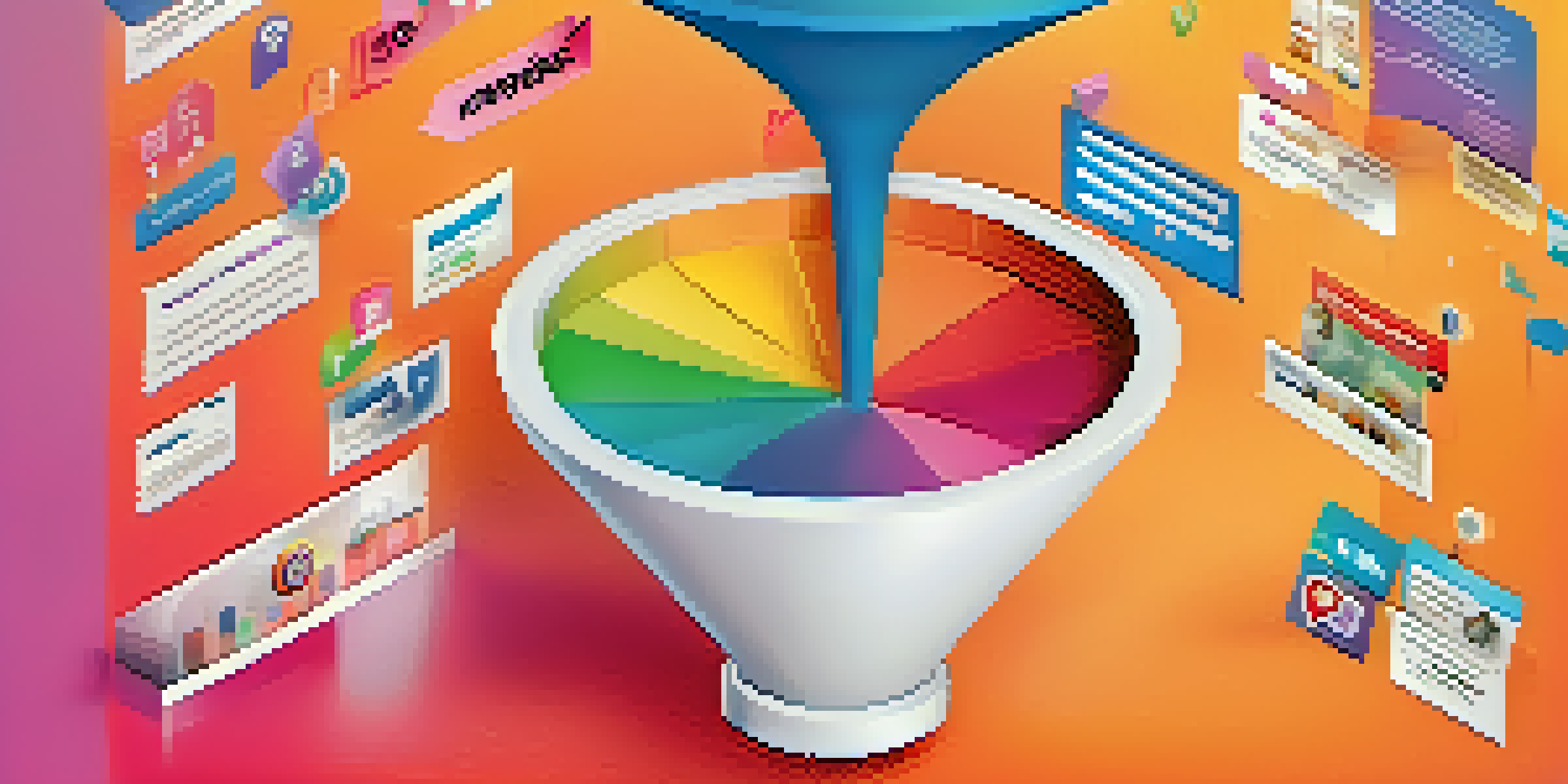Creating Compelling Content for Each Funnel Stage

Understanding the Marketing Funnel: An Overview
The marketing funnel is a model that represents the customer journey, from awareness to purchase. It helps businesses understand how potential customers interact with their brand. By visualizing this journey, you can tailor your content to meet the needs of your audience at each stage.
Content is fire, social media is gasoline.
Think of the funnel like a journey through a maze. At the top, you have a wide entrance where many people enter, and as they navigate through, only a few make it to the end. This metaphor highlights why it’s essential to create content that resonates with users at every turn to guide them toward making a purchase.
Ultimately, understanding the funnel allows you to create targeted content that not only engages but also converts. By recognizing where your audience is in their journey, you can provide them with the right information at the right time.
Top of the Funnel: Awareness and Attraction Content
At the top of the funnel, your goal is to attract attention and generate awareness. This is where engaging blog posts, social media content, and informative videos come into play. By providing valuable information, you can pique interest and draw potential customers to your brand.

Imagine hosting a fun party. You want as many people as possible to show up, so you send out eye-catching invitations and promote it on social media. In the same way, your content should be inviting and shareable to capture the attention of your target audience and encourage them to learn more.
Marketing Funnel Overview
The marketing funnel illustrates the customer journey, helping businesses tailor content to engage potential customers at each stage.
The key is to focus on providing solutions to common problems or answering questions your audience might have. This positions your brand as a helpful resource, laying the groundwork for deeper engagement further down the funnel.
Middle of the Funnel: Engaging and Nurturing Content
Once your audience is aware of your brand, it’s time to engage and nurture those leads. Middle-of-the-funnel content includes case studies, webinars, and email newsletters that provide deeper insights into your offerings. This content helps build trust and keeps your audience interested.
Marketing is no longer about the stuff you make but the stories you tell.
Think of this stage like dating; you’ve caught someone’s attention and now you need to foster that relationship. Just as you would share your interests and experiences to build a connection, your content should provide value and show how your product or service can solve their specific needs.
Nurturing your leads is crucial for guiding them further down the funnel. By providing informative and relevant content, you position your brand as a valuable partner, making it more likely that they will choose you when they’re ready to make a decision.
Bottom of the Funnel: Conversion-Focused Content
At the bottom of the funnel, your focus shifts to converting leads into customers. This includes product demos, customer testimonials, and special offers that encourage immediate action. At this stage, your content should be persuasive and highlight the benefits of your product or service.
Imagine you’re in a store trying to decide between two products. If one has glowing reviews and a special discount, you're more likely to choose it, right? This principle applies to your content as well; showcasing positive experiences and providing incentives can tip the scales in your favor.
Content for Each Funnel Stage
Attract, engage, and convert leads by creating specific content types for the top, middle, and bottom of the funnel.
The goal here is to remove any last-minute objections and make the purchasing decision as easy as possible. Clear calls to action (CTAs) should guide your audience toward taking that final step, ensuring they feel confident in their choice.
Creating Compelling Headlines for Each Stage
Your headlines are the first impression of your content, so they must grab attention. Each funnel stage requires a different tone and approach in your headlines to resonate with your audience effectively. For instance, awareness headlines should be intriguing, while conversion headlines should be direct and action-oriented.
Think of your headline as a storefront display. Just as a well-arranged display attracts customers, a compelling headline draws readers in. Use numbers, questions, or bold statements to create curiosity and encourage clicks.
Ultimately, your headline should reflect the content's value and entice the reader to continue engaging. Crafting effective headlines is a crucial step in ensuring your content reaches your target audience and fulfills its purpose.
Using Visuals to Enhance Content at Every Stage
Visual content plays a vital role in boosting engagement at all funnel stages. Infographics, videos, and images not only break up text but also communicate ideas quickly and effectively. In a world where attention spans are short, visuals can capture interest and convey messages in a more digestible format.
Consider how a great movie trailer entices viewers. It showcases the best parts without giving everything away, leaving the audience wanting more. Similarly, your visuals should complement your written content, highlighting key points and encouraging further exploration.
Measuring Content Success
Regularly analyze engagement metrics to refine your content strategy and ensure it meets audience needs.
By integrating visuals into your content strategy, you enhance the overall experience for your audience. This approach not only makes your content more appealing but also helps clarify complex ideas, making it easier for readers to understand and engage.
Measuring the Success of Your Content Strategy
Creating compelling content is just the beginning; measuring its success is equally important. Utilize analytics tools to track engagement metrics, conversion rates, and audience feedback. This data helps you understand what works and what doesn’t, allowing you to refine your content strategy over time.
Think of it like a chef tasting their dish before serving. By assessing the flavor, they can adjust the seasoning or cooking time for the perfect result. Similarly, analyzing your content’s performance enables you to make informed adjustments for better outcomes.

Regularly reviewing your content’s success will ensure that you’re continually meeting the needs of your audience. By staying agile and responsive to feedback, you can enhance your content’s effectiveness and drive better results for your business.